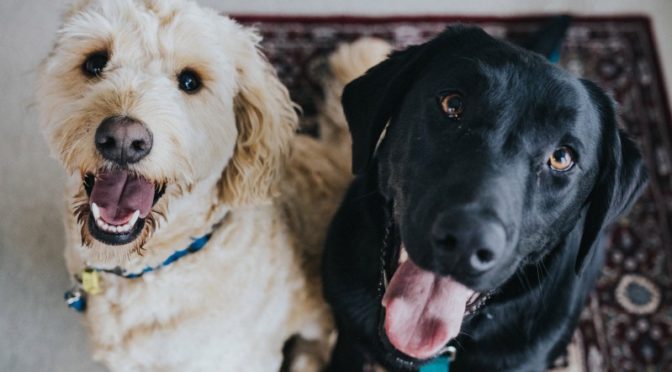
No matter where you live, you’re going to have a bedroom. And if you’re like most people, you’re going to want it to be a soft, cozy, and inviting area, which also means having a flooring that feels good beneath your feet and slippers. There’s a reason why concrete bedrooms never took off (at least for the non-incarcerated).
Unfortunately, the very things that make a bedroom pleasant for people are often those that make them easily damaged by pets. If you have a dog or cat, you’re going to have trouble finding floors that feel good when you walk on them while being tough enough to stand up to your four-legged friends. Today we’ll take a look at the best and worst bedroom flooring ideas to help you figure out which will work for your pet-friendly bedroom.
Do ceramic and porcelain tiles make good floors for pet owners?
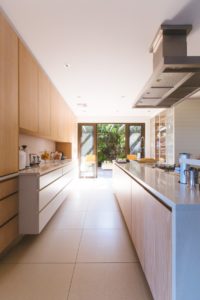
When it comes to pet care, ceramic and porcelain flooring are about as maintenance-free as it gets. Thanks to the glazed tile, you’re never going to see scratches, cracks, or stains, no matter how many cats and dogs play or pee on them. When you do get messes, whether of the bathroom kind or the illness kind, tile is very easy to clean up and sanitize. The closest thing to a problem you might have is skidding puppies due to the low friction of tile floors.
As a bedroom floor, ceramics and porcelains are less appealing options for comfort; the tiles will be cold in the winter and rather hard underfoot. However, if you’re willing to install a radius heat system, tile can be as warm as you want, and an area rug can take care of the hardness.
Vinyl is a cheap and nearly indestructible pet-friendly option
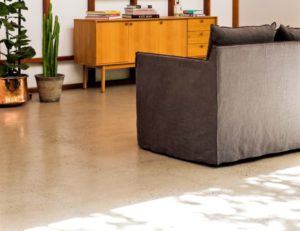
Vinyl is an excellent choice for a pet-friendly bedroom floor because it’s highly resistant to stains, scratches, and germs, and is one of the most durable floors on the market. It’s essentially a plastic coating for your floor; as a result, you can clean pet messes with ease without worrying about stains or residues that won’t come out.
You won’t often find vinyl in bedrooms, but this is changing with time. Homeowners are catching on to the fact that vinyl is modestly priced (i.e., cheap), waterproof, and available in just about any look or style you could ask for. The main drawback to it is the fact that it off-gases (as does any material primarily made from petroleum).
Natural stone is unconventional but beautiful

When it comes to standing up to pets claws and messes, it’s hard to find a more durable option than stones from mother nature. Natural stones are made from the mountains and won’t flinch against cat claws or dog paws. However, it’s important to note that some stones (e.g., marble) are likely to show scratches due to how polished they are upon arrival. You’ll want less shiny stones like granite, slate, or travertine if long-term appearance is a priority.
For humans, natural stones are a beautiful and natural alternative to ceramic or porcelain tiles, as they come directly from the earth. Since bedrooms are where we retreat to for security and intimacy, an organic material will be more in harmony with such an environment than a factory-made floor. The main downsides with stones are that, like tiles, they’re prone to feeling cold underfoot when winter arrives. However, as with tiles, you can install below surface radiant heaters to warm them up easily.
Which bedroom floors should pet owners avoid?
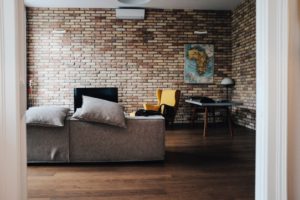
While hardwood, engineered wood, and bamboo floors are some of the most popular bare floors on the market, we don’t recommend them for bedrooms (or any other rooms) of pet owners. It’s not that they’re uncomfortable or likely to break down; the issues involve scratching, staining, and hygiene.

Specifically, larger dogs and neurotic cats can scratch wooden floors with their claws over time. You can sand down hardwood repeatedly, but as long as you have pets, you’ll keep getting the scratches. Engineered wood can only be sanded once or twice before you’re simply dealing with plywood. And beyond scratches, wooden floors, being organic, are far more likely to stain when urinated or vomited on, and if you don’t attend to these accidents promptly, you might find yourself dealing with greenhouses for germs.
Like wooden floors, carpets will work if you have to use them, but they’re not ideal for similar reasons. To be blunt, carpets are even harder to clean after pet messes; it’s why we have entire articles devoted to cleaning up cat and dog stains. If you don’t get to the stains quickly, they set in and become even more difficult to remove. Cats are also often attracted to carpet threads and turn them into giant scratching posts.
Which vacuum cleaners are most effective when cleaning up after pets?
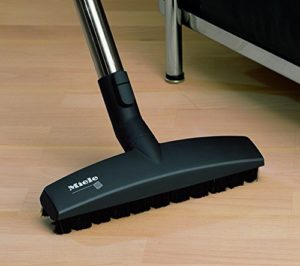
When it comes to cleaning up pet hair, dander, fur, or whatever else your dogs and cats are shedding all over your floors and upholstery, we recommend using vacuums with a lot of suction and the proper heads to get jobs done efficiently. For bare floors like hardwood, tile, or vinyl, you’ll want a Parquet head, which is about the most effective brush you can find for picking up hair and dirt instead of simply pushing it around.
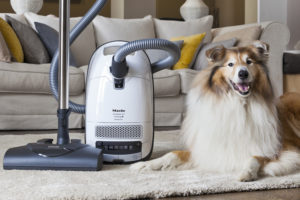
For carpets, an electric powered brush head will give you the power to pull fur and who-knows-what-else from carpets of all piles and styles without breaking a sweat. And a motorized mini brush will come in handy for cleaning the beds, sofas, and chairs your pets have claimed as their own. That said, it’s hard to find vacuums that feature all three. Two shining examples that do include everything we’re looking for are the Miele Complete C3 Cat & Dog (reviewed here and here) and Miele Compact C2 Electro+ (reviewed here and here); they’re also buy-it-for-life vacuums that will stand up to a lifetime of use in homes with kids, pets, and messy adults.
![]() You can buy the Miele Complete C3 Cat & Dog here on Amazon or buy the Miele Compact C2 Electro+ here.
You can buy the Miele Complete C3 Cat & Dog here on Amazon or buy the Miele Compact C2 Electro+ here.
![]() Canadians can buy the Miele C3 Cat & Dog here or buy the Compact Electro+ here.
Canadians can buy the Miele C3 Cat & Dog here or buy the Compact Electro+ here.
 If you find our research on PMC helpful, you can follow our efforts to keep maniacally reviewing home cleaning tools by shopping through our links above. We promise to keep fighting the good fight against every horror children, animals, and grown, yet messy humans can inflict upon a clean home.
If you find our research on PMC helpful, you can follow our efforts to keep maniacally reviewing home cleaning tools by shopping through our links above. We promise to keep fighting the good fight against every horror children, animals, and grown, yet messy humans can inflict upon a clean home.

